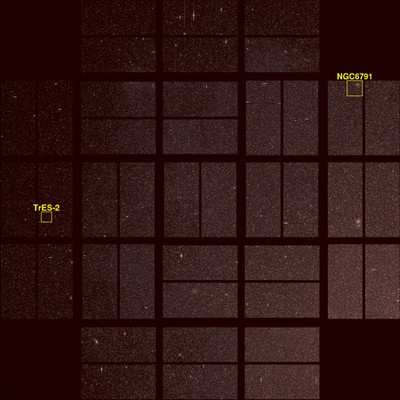Mission Will Search For Earth-like Worlds
NASA's Kepler mission has taken its first images of the
star-rich sky where it will soon begin hunting for planets like
Earth. The new "first light" images show the mission's target patch
of sky, a vast starry field in the Cygnus-Lyra region of our Milky
Way galaxy. One image shows millions of stars in Kepler's full
field of view, while two others zoom in on portions of the larger
region.

"Kepler's first glimpse of the sky is awe-inspiring," said Lia
LaPiana, Kepler's program executive at NASA Headquarters in
Washington. "To be able to see millions of stars in a single
snapshot is simply breathtaking."
One new image from Kepler shows its entire field of view -- a
100-square-degree portion of the sky, equivalent to two
side-by-side dips of the Big Dipper. The regions contain an
estimated 14 millions stars, more than 100,000 of which were
selected as ideal candidates for planet hunting.
Two other views focus on just one-thousandth of the full field
of view. In one image, a cluster of stars located about 13,000
light-years from Earth, called NGC 6791, can be seen in the lower
left corner. The other image zooms in on a region containing a
star, called Tres-2, with a known Jupiter-like planet orbiting
every 2.5 days.
"It's thrilling to see this treasure trove of stars," said
William Borucki, science principal investigator for Kepler at
NASA's Ames Research Center at Moffett Field, CA. "We expect to
find hundreds of planets circling those stars, and for the first
time, we can look for Earth-size planets in the habitable zones
around other stars like the sun."

Kepler will spend the next three-and-a-half years searching more
than 100,000 pre-selected stars for signs of planets. It is
expected to find a variety of worlds, from large, gaseous ones, to
rocky ones as small as Earth. The mission is the first with the
ability to find planets like ours -- small, rocky planets orbiting
sun-like stars in the habitable zone, where temperatures are right
for possible lakes and oceans of water.
To find the planets, Kepler will stare at one large expanse of
sky for the duration of its lifetime, looking for periodic dips in
starlight that occur as planets circle in front of their stars and
partially block the light. Its 95-megapixel camera, the largest
ever launched into space, can detect tiny changes in a star's
brightness of only 20 parts per million. Images from the camera are
intentionally blurred to minimize the number of bright stars that
saturate the detectors. While some of the slightly saturated stars
are candidates for planet searches, heavily saturated stars are
not.

Scientists and engineers will spend the next few weeks
calibrating Kepler's science instrument, the photometer, and
adjusting the telescope's alignment to achieve the best focus. Once
these steps are complete, the planet hunt will begin.
"We've spent years designing this mission, so actually being
able to see through its eyes is tremendously exciting," said Eric
Bachtell, the lead Kepler systems engineer at Ball Aerospace &
Technology Corp. in Boulder, CO. Bachtell has been working on the
design, development and testing of Kepler for nine years.
 ANN's Daily Aero-Linx (05.04.24)
ANN's Daily Aero-Linx (05.04.24) NTSB Final Report: Quest Aircraft Co Inc Kodiak 100
NTSB Final Report: Quest Aircraft Co Inc Kodiak 100 Aero-News: Quote of the Day (05.04.24)
Aero-News: Quote of the Day (05.04.24) Aero-News: Quote of the Day (05.05.24)
Aero-News: Quote of the Day (05.05.24) Read/Watch/Listen... ANN Does It All
Read/Watch/Listen... ANN Does It All





